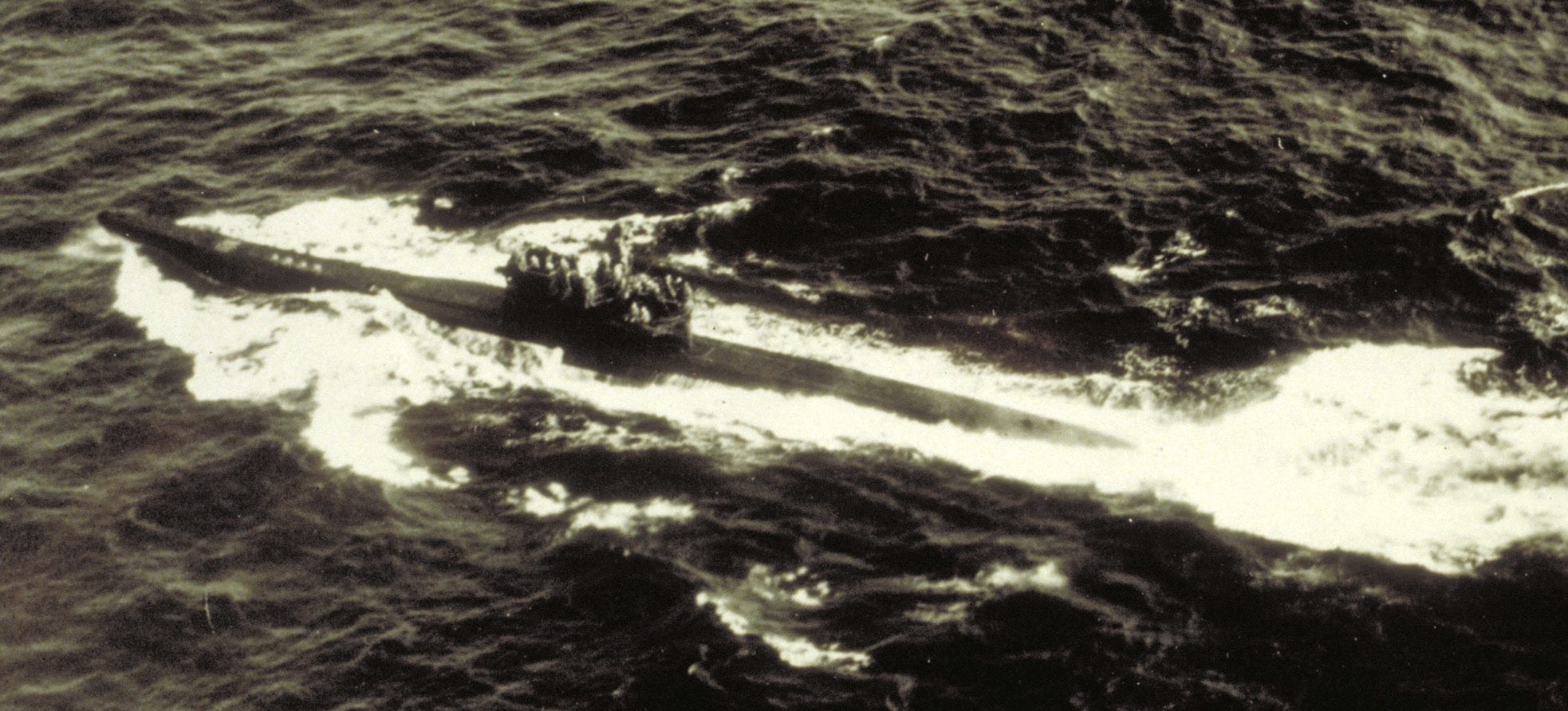Today on the blog, Aaron S. Hamilton gives an intriguing introduction to the U-1105 “Black Panther,” which is the topic of his book, German submarine U-1105 'Black Panther': The Naval Archaeology of a U-boat.
In 1995 a German Type VIIC submarine, U-1105 “Black Panther,” was designated the State of Maryland's first historic shipwreck preserve. This was a distinct honor given the number of historical shipwrecks that rest at the bottom of the Chesapeake Bay and its many tributaries.
Figure 19. U-1105 at the time of its surrender, May 9, 1945. (Courtesy of Maryland Historic Trust)
The U-1105 is the best preserved example of multiple transformative technologies employed by the Kriegsmarine during the last year of war that ushered in the future of modern submarine warfare. Many of these technologies remain misunderstood and their pivotal role in evolving undersea warfare inadequately documented.
Foremost, the “Black Panther” was equipped with a revolutionary device known as the Schnorchel (snorkel). The snorkel allowed a U-boat to stay submerged almost indefinitely and successfully patrol within the most heavily defended sea lanes from the English Channel to the St. Lawrence River. The snorkel drew in air for the crew and for the diesel engines enabling the U-boat to recharge its batteries while running just below the surface. This feature enabled what was a submersible torpedo boat to behave closer to a true submarine. The device was copied by all navies the world over after the war, and remains a feature even on nuclear powered submarines to this day. Second, it was equipped with the advanced GHG Balkon passive sonar array that significantly improved its underwater navigation and detection capability – a critical feature now that U-boats remained almost entirely underwater during their patrols. Third, U-1105 is best known for its rubber coating known as Alberich designed to reduce its acoustic signature while running submerged. This feature was not well understood by the Western Allies and after the war they spent significant resources trying to determine if the coating was intended to reduce the acoustic signature below the surface, or the radar cross section while on the surface. While the Soviet Navy quickly embraced the concept of Alberich and applied it to their submarine fleet in the 1950s, the U.S. Navy did not embrace this technology until the 1980s.
U-1105 employed these innovative technologies effectively, along with new shallow water tactics prescribed by U-boat Command. It avoided detection and engaged three modern Royal Navy destroyers from the vaunted 21st Escort Group and survived, claiming the HMS Redmill in the engagement during the last weeks of the war.
The story of U-1105 continued well beyond the end of the war. It was one of the most tested U-boats by the Royal Navy, sought after by the Soviet Navy, and ultimately spent an additional four years with the U.S. Navy where it was ingloriously used for salvage testing before being sent to the bottom of the Potomac River for the sixth and final time in 1949. It was also the last U-boat to sail across the North Atlantic under its own power in a dramatic crossing that nearly cost the lives of its joint U.S. and Royal Navy crew.
Figure 24. U-1105 in Holy Loch during its trials by the Royal Navy. (Courtesy of the Royal Navy Submarine Museum)
In the decades since U-1105's resting place was revealed to the public, it has remained largely ignored in historical and maritime archeological literature, beyond the two surveys undertaken by Maryland Historical Trust in the mid-1990s. This current study attempts to fill that void, and provide context to its significant technical innovations for the first time.
The only place in the world today where an accurate configuration of wartime snorkel trunking and Alberich can be viewed in near pristine condition is the U-1105. In fact U-995, a Type VIIC/41 on display in Laboe, Germany was equipped with an improved Type II snorkel installation before the end of the war that included the starboard-side exhaust trunking. When it was turned into a museum display, many of its key late-war features were removed, such as the starboard side snorkel trunking, offering an inaccurate portrayal of a late-war snorkel-equipped U-boat. (Click on this link to see the author's article published by the Deutsches U-Boot Museum for further discussion on this point.)
Despite the passage of almost 75 years after the end of World War II there is still much to learn from the "Black Panther." It's Type I flange snorkel mast that remains buried tantalizing inches below the river mud, as well as its Alberich are both priority candidates for further maritime archeological investigation. There is no surviving Type I snorkel mast this well preserved anywhere else in the world. Additionally, the Alberich configuration pattern varied depending on where it was applied along the hull. Further survey work could document this feature more fully so it can be compared to the original theoretical design models.
For the first time in print this unique U-boat's complete history is fully detailed. Every feature of U-1105 viewable above the river mud is fully documented with color photographs that serve as a guide for maritime archeologists, model builders, historians and anyone who enters the inky waters of the Potomac River to view one of the most historically significant U-boats of World War II.
To read more, order your copy of German submarine U-1105 'Black Panther': The Naval Archaeology of a U-boat now.



Comments
You must be logged in to comment on this post. Click here to log in.
Submit your comment